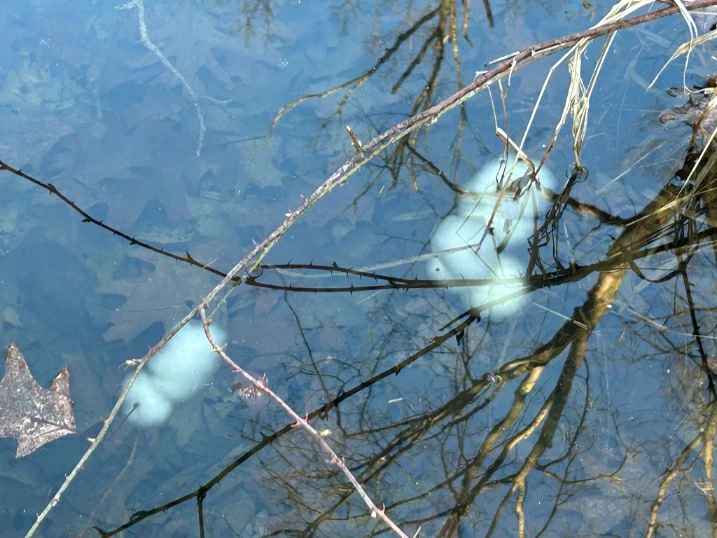Salamanders are quiet and secretive amphibians, often hiding where you might not see them. They need safe places to lay eggs so their young can survive and grow. You might wonder: where do salamanders lay their eggs?
Most salamanders lay eggs in water or very damp areas. They often attach eggs to plants, rocks, or other surfaces underwater. Some land-dwelling species lay eggs in moist soil or under logs where moisture stays and eggs stay safe.
Why Moisture Is Critical for Salamander Eggs
Salamander eggs don’t have hard shells. Instead, they have a soft, jelly-like coating that keeps the embryo safe. This coating needs water or damp conditions to stop drying out.

Most salamanders lay eggs near ponds, streams, or wetlands. Water keeps the eggs moist and helps deliver oxygen.
Without enough moisture, the eggs dry and won’t develop. Picking the right egg-laying spot is very important for salamanders.
Common Places Where Salamanders Lay Eggs
Salamanders use different strategies depending on their species and surroundings:
- Underwater plants: Many aquatic salamanders attach eggs to submerged plants. This keeps eggs safe from some predators and ensures water flow keeps them oxygenated.
- Under rocks or logs: Some species put eggs beneath rocks or damp logs, which shields them from strong currents, drying, and predators.
- Moist soil or leaf litter: Terrestrial salamanders often lay eggs on land under leaves, logs, or in burrows. These spots stay humid enough for the eggs to survive.
- Aquatic nests: Certain species build nests in water or wet spots to provide safe conditions for egg development.

These strategies make sure eggs stay moist, protected, and get enough oxygen.
How Egg-Laying Varies Among Different Salamander Species
Salamanders use very different methods to lay eggs depending on their species:
- Aquatic breeders: Spotted salamanders lay large clusters of eggs attached to underwater plants in ponds or temporary pools. These pools may dry seasonally but are safe during breeding.
- Stream dwellers: Salamanders in fast streams attach eggs under stones or in rock crevices. This protects eggs and ensures a steady water flow.
- Terrestrial breeders: Lungless salamanders lay eggs on land in hidden moist spots and often guard them until they hatch.
- Direct developers: Some species lay eggs on land that hatch directly into small adults, skipping the aquatic larval stage. This reduces risk from water predators but requires very moist land spots.
These differences show how salamanders adapt to their environment to give their young the best chance.
How Many Eggs Do Salamanders Lay?
The number of eggs depends on the species, size, and environment. Some salamanders lay only a few large eggs with lots of yolk, increasing survival chances. Others lay hundreds of smaller eggs so at least some survive.
Eggs usually come in jelly-like clusters, ranging from a few eggs to over a hundred, depending on the species.
Parental Care: How Salamanders Protect Their Eggs
Some salamanders leave eggs alone, trusting the environment to protect them. Others stay close to guard them.

Guarding salamanders keep eggs safe from predators, fungi, and drying. Some wrap their bodies around the eggs to maintain moisture. This care greatly improves survival.
How Long Do Salamander Eggs Take to Hatch?
Eggs take different times to hatch depending on species, temperature, and moisture. Usually, eggs hatch in two to eight weeks. Warmer temperatures speed up development, cooler or less humid conditions slow it down.
Once hatched, larvae move into water to feed and grow before changing into adults.
Threats to Salamander Eggs in the Wild
Eggs face many challenges:
- Predators: Fish, insects, other amphibians, and birds eat eggs.
- Drying out: Eggs exposed to air or low moisture die.
- Fungal infections: Fungi can kill embryos if eggs aren’t well protected.
- Pollution: Chemicals in water harm egg development and hatching.
Choosing hidden, moist spots helps eggs survive.
The Importance of Habitat for Salamander Reproduction
Having the right habitat matters a lot. Wetlands, ponds, streams, and moist forest floors give ideal egg-laying conditions.
Human actions like draining wetlands, cutting forests, and polluting water reduce these habitats and threaten salamander reproduction. Protecting these areas is important for their survival.
What Happens After Salamander Eggs Hatch?
When eggs hatch, larvae usually enter water. They look like tiny salamanders but have external gills to breathe underwater. They swim and feed until they are ready to change into adults.
During metamorphosis (the change from larva to adult) they lose gills, develop lungs or rely on skin breathing, and get ready for life on land or in water.
Unique Egg-Laying Behaviors Found in Salamanders
Some salamanders show unusual behaviors:
- Egg guarding: Staying near eggs to protect them.
- Brooding: Carrying eggs on their backs or in pouches until hatching.
- Scattered egg laying: Laying eggs in small groups or individually to reduce predation risk.
These behaviors show how adaptable salamanders are in reproducing.
How Human Activity Affects Salamander Egg-Laying
Humans affect salamander reproduction through pollution, habitat loss, and climate change.
- Draining wetlands or logging removes breeding spots.
- Chemical pollution harms eggs and larvae.
Protecting aquatic and land habitats is key to keeping salamanders thriving.
How to Observe Salamander Eggs Responsibly
If you see salamander eggs in the wild, watch without touching. Do not move or handle eggs, they are delicate. Observing from a distance helps eggs survive and keeps salamanders safe.
Conclusion
Where do salamanders lay their eggs? Most species lay eggs in water or very damp spots. They often attach eggs to plants or hide them under rocks, logs, or moist soil to keep them safe.
Different species use different strategies, from underwater egg masses to land clutches. Protecting these habitats is critical for their survival.
Understanding how salamanders lay eggs helps you appreciate their life cycle and the fragile balance of their ecosystems.
Hi, my name is Ezra Mushala, i have been interested animals all my life. I am the main author and editor here at snakeinformer.com.

